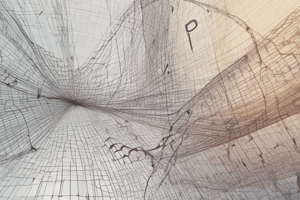Podcast
Questions and Answers
What distinguishes vectors from scalar quantities?
What distinguishes vectors from scalar quantities?
- They only have direction
- They have magnitude and direction (correct)
- They always point downward
- They only have magnitude
How is the magnitude of a vector defined?
How is the magnitude of a vector defined?
- As the orientation of the vector
- As a scalar quantity
- As the size of the quantity represented by the vector (correct)
- As the angle between two vectors
What does the direction of a vector indicate?
What does the direction of a vector indicate?
- The orientation of the quantity being described (correct)
- The sum of two vectors
- The size of the quantity
- The angle between two vectors
How are two vectors added algebraically?
How are two vectors added algebraically?
In vector addition, what does the resultant vector's magnitude depend on?
In vector addition, what does the resultant vector's magnitude depend on?
What determines the direction of the resultant vector in vector addition?
What determines the direction of the resultant vector in vector addition?
What does subtracting two vectors involve?
What does subtracting two vectors involve?
In physics, which operation corresponds to finding the change in position after accounting for displacements?
In physics, which operation corresponds to finding the change in position after accounting for displacements?
What is the result of multiplying a vector by a scalar?
What is the result of multiplying a vector by a scalar?
Which field does not utilize vectors for various quantities?
Which field does not utilize vectors for various quantities?
What is a common application of vectors in computer graphics?
What is a common application of vectors in computer graphics?
How do vectors help in representing directions along with measurements?
How do vectors help in representing directions along with measurements?
Flashcards are hidden until you start studying
Study Notes
What Are Vectors?
Vectors are mathematical objects used to represent physical quantities such as displacement, velocity, acceleration, and force. They can also represent abstract concepts like changes in temperature or pressure. The most common type of vector is one that has both magnitude and direction, which makes it distinct from simple scalar quantities. To understand vectors better, let's break down their components.
Components of Vectors
There are two fundamental components of a vector: its magnitude and direction. Magnitude refers to the size of the quantity being represented by the vector; for example, the distance between two points on a map could be represented by a vector where the magnitude represents the length of that line segment. On the other hand, direction indicates the orientation of the quantity being described. For instance, the displacement of a person traveling north could be represented by a vector pointing upward along the north axis.
Operations on Vectors
Vector algebra introduces several operations that help us manipulate vectors mathematically:
-
Addition: Adding two vectors involves placing them end-to-end and drawing a new vector from the tail of one vector to the head of the second vector. The magnitude of the resultant vector is equal to the sum of the magnitudes of the original vectors, and its direction is determined by the angle between them. This operation represents the concept of displacement in physics when two displacements are combined.
-
Subtraction: Subtracting two vectors can be done by adding their opposite or negatives. So if (\mathbf{v}) and (\mathbf{w}) are two vectors with heads at points (P) and (Q) respectively, then (\mathbf{v} + (-\mathbf{w})) represents a vector from point (P) to point (R), which is a reflection of (Q) about line (PQ). In physical terms, this operation corresponds to finding the change in position that would move you from one place to another after accounting for both displacements.
-
Scalar Product (Dot Product): Multiplying a vector by itself gives us its square; multiplying any vector by a scalar multiplies all components of the vector by that scalar factor. For example, if (\mathbf{v}) is a unit vector pointing east, and we scale it down by half ((0.5 \mathbf{v})), then this new vector points only halfway toward the east.
Applications of Vectors
Vectors play an important role across various fields where quantities have both size and direction. Here are some examples:
- Physics: Displacement, velocity, acceleration, force, moment, angular momentum, electric field strength, magnetic field intensity.
- Engineering: Force, torque, stress, strain, current density.
- Geometry: Position, direction, distance, speed, rate of rotation.
- Economics: Rate of growth, inflation, interest rates.
- Computer Graphics: Translation, rotation, scaling, shearing, perspective.
In summary, vectors provide a concise way of representing directions along with measurements, enabling us to quantify changes in our surroundings and assess differences between points on maps or graphs. They allow us to perform calculations such as addition or subtraction without losing the essential information about the size and orientation of each quantity being compared.
Studying That Suits You
Use AI to generate personalized quizzes and flashcards to suit your learning preferences.




